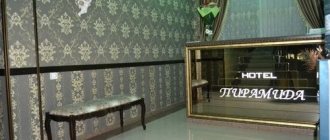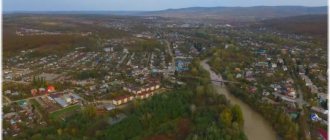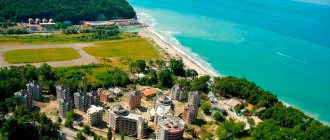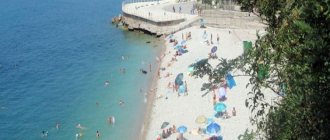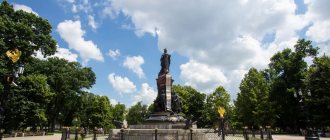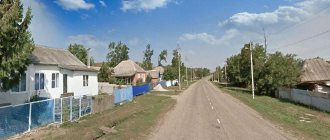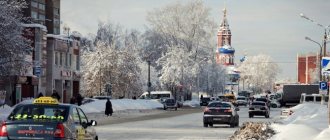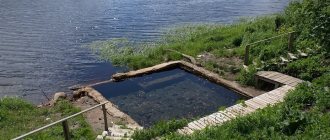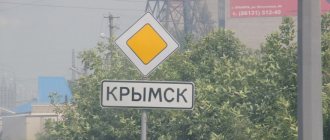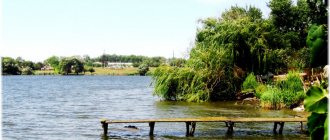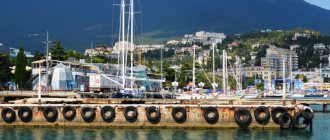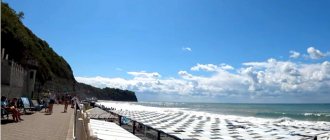The Krasnodar region is one of the most favorite places for Russians to spend their summer holidays. They call it everything: health resort, granary, sunny paradise, etc. Various festivals and political forums take place here. The local air is very good for health, which is why the resorts of the Krasnodar Territory are so popular. There are so many of them that it is difficult to even name the exact number. The Black and Azov seas, mountains, and the amazing beauty of nature attract people like a magnet.
Abinsk - sunny paradise
The combination of sea and mountain air gives amazing results: many diseases are cured, the human body becomes healthier, and vitality increases. Recently, a huge number of people not only go on vacation to the Krasnodar region, but stay to live here. One of the popular cities is Abinsk. Reviews from people who moved here are full of delight and admiration for living here. We offer you the necessary information about the city. Where is Abinsk? What establishments are there? Where you can get a job and other useful information for those who are planning to change their place of residence to a wonderful southern city.
Abinsk, Krasnodar region. History and facts
In the area of the Abin River, from which the name of the city came, many people have always lived. The first information about people living in this area was obtained several thousand years BC. At first it was a small settlement, then a village, a military fortress, and a village. It was founded in the mid-19th century. Friendly Cossacks lived here. They did everything together: celebrated holidays and weddings; shared grief and troubles; supported each other. Good traditions have been preserved in the 21st century. Residents celebrate holidays and important dates in the history of Abinsk together. The city status was obtained in the mid-20th century, and it is only a little over fifty years old.
The closest neighbors are Krymsk, Krasnodar, Gelendzhik, Novorossiysk. Famous people stayed in the city: Tsar Alexander III, military leader Anton Ivanovich Denikin, Decembrists Alexander Besstuzhev-Marlinsky and Alexander Odoevsky, writers Anton Pavlovich Chekhov and Fyodor Mikhailovich Dostoevsky, chemist Dmitry Ivanovich Mendeleev. Abinsk is called the pearl of Kuban. People come here from different cities of Russia.
LiveInternetLiveInternet
Quote from PRINCE_IGOR
Read in full In your quotation book or community!
ABINSK
The city is located in the foothills of the Caucasus on the banks of the Abin River. Slightly less than half of the city's territory is occupied by forests. Abinsk is located on the very border of the steppe and rocky mountains. The entire mountainous part of the town is dotted with streams, rivulets and small rivers. In the vicinity of Abinsk there are mud springs, dolmens, and a climbing range.
Coat of arms of Abinsk
In a purple field under a wavy crossed golden and green dome, thinly bordered with gold, there is a golden fortification standing on an azure wavy extremity with closed wooden gates, a tower with a black loophole and a pointed roof on pillars, crowned with a pennant with two braids of the same metal; On the sides of the gate there are golden earthen ramparts, reinforced with wicker reinforcement, on which there are two rounds of the same metal, between which directly facing golden cannons with black muzzles are visible. On the sides and below there is a golden border, burdened with 12 green oak leaves.
The Abinsk fortification, built by the Cossacks on the banks of the Abin River, later became the basis of the village of Abinskaya, which in 1963 received the status of a city. The coat of arms of the urban settlement shows an ancient fortress (a symbol of protection, security, barrier), standing on the azure river. The green wavy stripe at the top is an allegory of the foothills of the Caucasus, in which the territory of the urban settlement is located.
The symbolism of oak (oak leaves) is multi-valued: - a symbol of fortitude, inflexibility, perseverance; - a symbol of fertility, prosperity. - a symbol of endurance, durability, immortality. The symbolism of the number 12 (“dozen”, compare “to be able to do it”) is positive, in contrast to the symbolism of the number 13 (“the devil’s dozen”). Examples of the number 12: there are 12 months in a year; 12 hours day and night; 12 apostles of the Christian church. Purple - symbolizes power, glory, honor, greatness, nobility of origin, antiquity. Azure is a symbol of the Abin River, as well as a symbol of lofty aspirations, sincerity, devotion, and rebirth. Gold is a symbol of the highest value, greatness, generosity, wealth, harvest. Green color symbolizes spring, health, nature, hope.
The founding date of Abinsk can be considered the moment of the founding of the city of Abun. And although the exact date of this event is unknown, it can be assumed that it happened no later than the first century AD, since a certain time must pass for the name of the city to appear on the geographical map. It is known that words that came from the depths of centuries tend to transform, so the word Abun was transformed into Abin, and then into Abinsk. It turns out that the city of Abinsk has a long history, dating back no less than 2000 years. Since ancient times, the Abin River valley has been densely populated. Even now, stone tools are found here: axes, adzes, scrapers made from flint, but more often from local sedimentary rocks (marl, sandstone). They were left by Stone Age people - hunters and gatherers. On the territory of the region, many dolmens have been preserved - ancient burials, contemporaries of the Egyptian pyramids, whose age is up to 4500 years. Reconnaissance carried out by the South Kuban archaeological expedition discovered several settlements in the vicinity of Abinsk, which served as fortified points to protect the peoples living here. They were erected in times distant from us and could be passed on to subsequent peoples, who also used them for their intended purpose. Less than 10 people of both sexes rarely lived in one yard. Often, together with servants, prisoners and slaves, there were 40 or more inhabitants per yard, on average 20 people lived in each yard. In the village there were no public buildings (shops, shops, mosques), places of entertainment, squares, or even demolition roads, but the village was fortified with trenches and rubble.
In 1834, the population of the village of Abin was sent to settle in Turkey, and on the site of the settlement, the Abin Fortress was built under the leadership of General Velyaminov. The fortification was located on the high left bank of the Abin River and occupied an area of about 5 hectares. The boundaries of the fortification had the shape of a hexagon. From the outside, the fortress was protected by an earthen rampart more than 2 m high and a dry ditch up to 4 m deep. In addition, the fortification had powerful artillery, located in such a way that the entire surrounding area was covered during volleys of flank and frontal fire. Inside the fortification, several barracks for soldiers, three outbuildings for the commandant of the garrison, officers, a doctor and a priest, a church and several barns were hastily built.
In 1854, during the Crimean War, the Abinsk fortification was abolished, the garrison was withdrawn, and the structures were destroyed. After the end of the Caucasian War in 1862, a regulation was adopted on the settlement of the western part of the North Caucasus by Cossacks. According to this provision, the Cossacks from the troops of the Adagum detachment began to build new villages, most of which were located on the territory of the former fortifications. To the north of the previously destroyed bastion, a new Abinsk camp was built, where the headquarters of the Crimean Infantry Regiment, a foot battalion and a squadron of the Seversky Dragoon Regiment were transferred.
In April 1863, an order was issued to resettle the Azov Cossacks to the Caucasus. May 8 (20, old style) 1863, when the first sixteen Cossack families under the command of sergeant G. Kulik arrived at the Abinsk camp and began construction work on the construction of residential buildings, is officially considered the date of the founding of the village of Abinskaya. In June-July, another 488 families of Azov Cossacks were transported to the Abinsk camp. Cavalier of St. George E.M. Gladky was appointed head of the village. At the end of July, the first village-wide meeting took place, at which the first officials were elected. By October 1863, the village was finally rebuilt. In 1868, the first wooden church was built on the left bank of the Abin River in honor of St. Nicholas the Wonderworker.
Construction of educational institutions was also underway. In the fall of 1867, the first school was opened in the village of Abinskaya, in November 1874, with funds from the Ekaterinodar Charitable Society, a women's school was opened, and in 1897, a Sunday school for adults was organized.
In 1868, near the village of Abinskaya, Colonel A.I. Novoseltsev discovered an oil source. This discovery gave rise to the successful development of oil fields. In 1879, in the village of Abinskaya, the American engineer G. Twerdle installed the first oil pipeline station. In 1880, the great Russian chemist D.I. Mendeleev visited the oil fields in the village of Abinskaya.
The infrastructure of the village gradually developed. In 1885, an oil mill was built in the village. In the same year, a railway bridge was thrown across the Abin River, and in 1887 the building of the Abinskaya railway station was built, which became one of the intermediate stations on the Ekaterinodar-Novorossiysk railway line.
At the beginning of the twentieth century, the industrial, commercial and spiritual development of the village was in full swing. In 1901, construction of the Holy Intercession Church was completed on the territory of the village. In 1902, the manufacturer S.S. Kurguzov built a narrow-gauge horse-drawn railway, initially connecting his mill and oil mill with the railway station. In 1914 S.S. Kurguzov donated the access roads to the village. This is how public transport appeared - a horse-drawn carriage, consisting of a single carriage, and operating until 1919.
In 1914, the largest Russian and Petrograd Export and Trade Joint Stock Company began their activities in the village of Abinskaya.
In 1916, on the eve of the overthrow of the royal family and the establishment of the era of Soviet power, some residents of the village became ardent Red Army followers. These include, first of all, the industrialist brothers Kurguzov, who in every possible way contributed to the dissemination of Soviet views. Thus, in 1916, in the village of Abinskaya, an underground committee of the RSDLP (b) was created, based at a flour milling plant owned by the Kurguzov brothers. In September 1917, the first trade union of flour mill workers was formed at the same plant.
In December 1917, in the village of Abinskaya, the “Union of Nonresidents”, the Council of Workers, Peasants, Soldiers and Cossack Deputies, and the Military Revolutionary Committee were created. However, the majority of local residents were against the establishment of Soviet power. During the difficult years of the Civil War, the White Guards either seized power, then again lost ground. And only in the spring of 1920, Soviet power was finally established in the North Caucasus. At this time, the first agricultural communes, a folk choir, and a public library were created in the village of Abinskaya.
In 1924, the borders of the Abinsk region were formed with the center in the village of Abinskaya, which was part of the Kuban-Black Sea region.
In 1930, collective farms “Red Tamanets”, “Industry”, “Red Gardener”, “Northern”, “International”, named after S. M. Kirov were organized here. In 1936, the Abinsk Folk Choir, already famous throughout the country, as part of the Kuban Combined Choir, performed at the Bolshoi Theater in front of all members of the government.
The village of Abinskaya was occupied by the Nazis in the summer of 1942. During the occupation, the Nazis resorted to repression of the local population and established strict access procedures for movement from populated areas and back. The German invaders detained “suspicious” local residents, shot them, and their homes were looted and burned to the ground. During this difficult time, partisan detachments were formed on the territory of the Abinsk region, which included both destroyer battalions and local pioneer schoolchildren. On March 23, 1943, the village of Abinskaya was liberated from the occupiers, and the partisan detachments were disbanded.
At the end of 1962, the village of Abinskaya received the status of a workers' village, and a year later, in the fall of 1963, the workers' village of Abinsk was transformed into the city of Abinsk.
Currently, the city of Abinsk is the administrative center of the Abinsk urban settlement and the Abinsk district of the Krasnodar Territory.
There are many attractions in the city and its surroundings:
On the left bank of the Adegoy River there is the Great Shapsugsky burial ground, which has more than a thousand mounds, some of which have preserved gravestones with Christian crosses carved on them. This indicates the spread of Orthodoxy among the ancient Circassians.
In the upper reaches of the Adegoy River in the Abinsk region there is the Bolshoi Adegoy waterfall, the height of which reaches 10-11 m. Somewhat higher and lower than it there are several more waterfalls that will create a whole cascade with a total height of up to 40 m.
The Count Ruins waterfall is located on the right tributary of the Papaya River. The length of the waterfall reaches 11 m and the width is 4 m.
On the right side of the Khabl River valley in the Abinsk region there are New Rocks. They are a pile of blocks of various shapes, consisting of sandstone. The height of the rocks is no more than 15 m. The New rocks are interesting for training sports climbers who are polishing their skills.
Near the Solontsy mud volcano there is a separate rock, which was split into several parts as a result of the explosion. The rock is called "Devil's Finger". Its height is 15 m.
On the southern slope of Mount Chubatoy, in the valley of the Khabl River, you can see natural stone sculptures resembling giant mushrooms.
Mount Svintsovaya, 683 m high, has a regular pyramidal shape. From its top there is a magnificent view of the city of Abinsk and part of the Black Sea.
Mount Shize has a height of 542 m and is the highest point of the Gruzinka ridge. The southern slopes of the mountain are steep and have a typical rocky outcrop. The Erivan peak of Mount Shize is an excellent panoramic point. And the flat watershed of the mountain ridge, overgrown with wild apple trees, pears, dogwoods, and rose hips, in the spring represents the splendor of a blooming garden.
In the Abinsk region, 57 objects of regional significance are classified as natural monuments. For example, the alpine meadows of the Bald Mountains, the forest park of former military camps; the valley of the Abin River, the Red Oak Grove, Maslova Mountain, the Chubataya and Shize mountains, centuries-old oak trees on the way to the village of Shapsugskaya, under the shadow of which Lermontov rested, the mountain-geological formation “Monasteries”, numerous dolmens and many others.
What you need to know if you decide to move to Abinsk
To ensure that you feel comfortable and cozy at your new place of residence, please take note of the following information:
- Be sure to find out in advance the necessary phone numbers: calling a doctor at home, help desk, emergency, taxi. You can also find out the addresses of hotels and guest houses, in case you need this information.
- It is necessary to find as much information as possible about housing prices, work and public transport.
- In summer and autumn there are a large number of vacationers and housing prices are much higher than in spring and winter. Keep this in mind when planning your move.
- If you want to rent or buy a home, it is better to use the services of a real estate agency, whose address and telephone numbers should be clarified in advance.
- Don’t rush to get upset and upset if something doesn’t go the way you would like in your new place. Remember that these are just temporary difficulties and everything will definitely work out for the better.
Abinsk: reviews from those who moved
About 38 thousand people live in the city. Among the indigenous population there are a lot of visitors from Moscow, St. Petersburg, Yekaterinburg and other cities. According to those who came, the place here is very beautiful and amazing. On one side there are steppes, on the other there are mountains. Several rivers flow through: Kuban, Abin, Adegoi. You can get to the sea by bus or car in a few hours.
You come here and immerse yourself in an atmosphere of boundless happiness and freedom. And the clean air even makes your head spin.
Literature
- [dic.academic.ru/dic.nsf/city_of_russia/6/%D0%90%D0%B1%D0%B8%D0%BD%D1%81%D0%BA Abinsk] // Cities of Russia: encyclopedia. - M.: Great Russian Encyclopedia, 1994. - P. 13. - 559 p. — 50,000 copies. — ISBN 5-85270-026-6.
- [www.okorneva.ru/naselennyie-punktyi-stavropolskoy-gubernii-i-kubanskoy-oblasti/abinskaya-stanitsa-tamanskiy-otdel/ Abinskaya village (Taman department) in the book Handbook of the Stavropol diocese (review of cities, villages, villages and hamlets Stavropol province and Kuban region). N. T. Mikhailov. 1911]
Abinsk: reviews of leisure facilities from those who moved for permanent residence
There are many places in the city where you can have a great time together or with a large group. The Red Kangaroo bowling club is extremely popular. You can order a track in advance and no longer worry about there being no free places to play. The good news is that you can buy light snacks or a full meal here.
Numerous residents of the city list among their options for spending their leisure time a trip to the sauna “On Tulskaya”. It is located on the street of the same name. You can come here with a group of up to ten people. After a good steam and rest, you can sing karaoke or watch a movie. A great addition to your vacation will be food and alcoholic drinks.
The indigenous residents of the city and those who have recently settled in love to relax in the Kubanochka cafe. Among the advantages of the establishment, numerous visitors note the light, unobtrusive music and the variety of dishes of European and Russian cuisine.
In order to obtain the most complete information about all leisure and cultural institutions, residents are advised to use the directory of city organizations. In it you can find all the necessary addresses and telephone numbers. The directory can be purchased at all kiosks in Abinsk.
Attractions
One of the most famous places in the Abinsk region is the village of Shapsugskaya. It attracts the attention of tourists from all over the world. What's interesting here?
Firstly, a large number of dolmens. They say that you must make wishes near them, which will certainly come true.
Secondly, sources of “living” and “dead” water. They have it even in dry periods. Thirdly, Big Adegoy waterfall. A huge number of reviews about how mesmerizing the spectacle of a falling avalanche of water is attracts new visitors.
Another nuance that has been noted by numerous reviews: equipment here very often breaks down and strange phenomena occur. Local residents call this zone anomalous and believe that here you can recharge with positive energy.
The best hotels in the city and the private sector
If you came to Abinsk to first get to know the city, and only then decide whether it’s worth moving here, there are several options where you can stay. The Europe Hotel is very popular among holidaymakers. The rooms here are of different price categories; you can rent them for 1,200 rubles. per day. Cleanliness, three meals a day and polite staff.
You can stay in private houses; Abinsk offers tourists a variety of options. Reviews from those who have moved indicate that housing prices are pleasantly pleasing. Especially in the private sector. You can buy a house or apartment much cheaper than in nearby cities and towns. Reviews from those who moved to Abinsk, to the private sector, are full of enthusiastic emotions.
Content
- 1 Climate
- 2 History
- 3 Population
- 4 Economics
- 5 Education 5.1 Pre-school education
- 5.2 Secondary education
- 5.3 Primary vocational education
- 5.4 Secondary vocational education
- 5.5 Additional education
Climate
The climate in Abinsk is temperate continental. The beginning of summer in Abinsk falls on the first ten days of May. In summer, the average air temperature reaches +25°C, in the hottest months it rises to +35°C. Winter is characterized by frequent thaws. Winter in Abinsk begins in the last five days of December. In the autumn months, temperatures in Abinsk are often high for this time - up to +30°C, which determines the duration of the holiday season for at least 8 months. Up to 650 mm of precipitation falls annually.
Where to find work in Abinsk?
If you have not done this in advance, then be sure to use the services of the employment center of the Abinsk region. The establishment is located on Respublikanskaya Street, 40. From the railway station you can get here by buses No. 1 and 2, stop “Center”. Specialists will help you quickly find a job in the city, as they have collected all the information about available vacancies that Abinsk (Krasnodar Territory) provides. Reviews from those who have moved indicate that there are usually no problems with finding a job.
According to them, there are a large number of options. Near the city, oil is extracted, there is a sewing factory, furniture showrooms, industrial enterprises, and food factories. There are options for part-time work at home that can be found on Internet sites.
Education
| : Incorrect or missing image | This section is missing references to information sources. Information must be verifiable, otherwise it may be questioned and deleted. You may edit this article to include links to authoritative sources. This mark is set November 24, 2015 . |
K:Wikipedia:Articles without sources (type: not specified)
Preschool education
- Kindergarten No. 1
- General developmental kindergarten No. 2 “Cossack”
- General developmental kindergarten No. 4
- General developmental kindergarten No. 5 “Smile”
- General developmental kindergarten No. 7
- General developmental kindergarten No. 31
- General developmental kindergarten No. 33
- General developmental kindergarten No. 34 “Golden Key”
- Combined kindergarten No. 39 “Stork”
- General developmental kindergarten No. 43
Secondary education
- Secondary school No. 1
- Special correctional general education boarding school No. 2
- Secondary school No. 3
- Secondary school No. 4
- Secondary school No. 38
Primary vocational education
- Vocational school No. 30
Secondary vocational education
- branch of the Anapa Industrial College
Additional education
- Children's and youth sports school "Victoria"
- Children's and youth sports school "Spartak"
- Children's and youth sports school "Yunost"
- The House for arts and crafts for children
- Children's art school
- Center for extracurricular activities "Patriot"
Conclusion
A wonderful settlement with a well-developed infrastructure, friendly and talkative residents - the city of Abinsk. Reviews from those who moved for permanent residence convince us of this. There is everything you need for a normal life and raising children. It’s a little disappointing that salaries are lower than in cities such as Novorossiysk, Gelendzhik and Krasnodar. But there are relatively low prices for housing and food here.
If you are tired of big, noisy cities, come to Abinsk (Krasnodar Territory). Reviews from those who moved (many people dream of permanent residence here) are only positive. A clean and well-kept city attracts people from all over Russia. Young people actively come here and then transport their parents. It is growing and developing, and who knows, perhaps after some time the city of Abinsk will become one of the largest cities in the Krasnodar Territory. Reviews from those who moved convincingly prove this to us.
Notes
- ↑ 123
www.gks.ru/free_doc/doc_2016/bul_dr/mun_obr2016.rar Population of the Russian Federation by municipalities as of January 1, 2016 - ↑ 12
Great Russian Encyclopedia: In 30 volumes / Chairman of scientific editor. Council Yu. S. Osipov. Rep. edited by S. L. Kravets. T. 1. A - Questioning. - M.: Great Russian Encyclopedia, 2005. - 766 p.: ill.: map. - [slavakubani.ru/read.php?id=1142 V. P. Ponomarev “From the history of the founding of the village of Abinskaya”]
- Abinskaya // Encyclopedic Dictionary of Brockhaus and Efron: in 86 volumes (82 volumes and 4 additional). - St. Petersburg, 1890-1907.
- Azarenkova A.S., Bondar I.Yu., Vertysheva N.S.
The main administrative and territorial transformations in Kuban (1793-1985). - Krasnodar: Krasnodar Book Publishing House, 1986. - P. 239. - 395 p. - ↑ 12345678910111213
www.MojGorod.ru/krasnod_kraj/abinsk/index.html People's encyclopedia “My City”. Abinsk - [demoscope.ru/weekly/ssp/rus70_reg2.php All-Union Population Census of 1970 The size of the urban population of the RSFSR, its territorial units, urban settlements and urban areas by gender.] (Russian). Demoscope Weekly. Retrieved September 25, 2013. [www.webcitation.org/6GDOiMstp Archived from the original on April 28, 2013].
- [demoscope.ru/weekly/ssp/rus79_reg2.php All-Union Population Census of 1979 The size of the urban population of the RSFSR, its territorial units, urban settlements and urban areas by gender.] (Russian). Demoscope Weekly. Retrieved September 25, 2013. [www.webcitation.org/6GDOjhZ5L Archived from the original on April 28, 2013].
- [demoscope.ru/weekly/ssp/rus89_reg2.php All-Union Population Census of 1989. Urban population]. [www.webcitation.org/617x0o0Pa Archived from the original on August 22, 2011].
- [www.perepis2002.ru/ct/doc/1_TOM_01_04.xls All-Russian Population Census 2002. Volume. 1, table 4. Population of Russia, federal districts, constituent entities of the Russian Federation, districts, urban settlements, rural settlements - regional centers and rural settlements with a population of 3 thousand or more]. [www.webcitation.org/65AdCU0q3 Archived from the original on February 3, 2012].
- [www.gks.ru/bgd/regl/B09_109/IssWWW.exe/Stg/d01/tabl-21-09.xls Number of permanent population of the Russian Federation by cities, urban-type settlements and districts as of January 1, 2009]. Retrieved January 2, 2014. [www.webcitation.org/6MJmu0z1u Archived from the original on January 2, 2014].
- [krsdstat.gks.ru/wps/wcm/connect/rosstat_ts/krsdstat/resources/78c336004176a36791ffdd2d59c15b71/pub-01-04.pdf All-Russian Population Census 2010. Volume 1, table 4. Urban and rural population by gender in the Krasnodar Territory]. Retrieved January 2, 2015. [www.webcitation.org/6VHuBHcSP Archived from the original on January 2, 2015].
- [www.gks.ru/free_doc/doc_2012/bul_dr/mun_obr2012.rar Population of the Russian Federation by municipalities. Table 35. Estimated resident population as of January 1, 2012]. Retrieved May 31, 2014. [www.webcitation.org/6PyOWbdMc Archived from the original on May 31, 2014].
- [www.gks.ru/free_doc/doc_2013/bul_dr/mun_obr2013.rar Population of the Russian Federation by municipalities as of January 1, 2013. - M.: Federal State Statistics Service Rosstat, 2013. - 528 p. (Table 33. Population of urban districts, municipal districts, urban and rural settlements, urban settlements, rural settlements)]. Retrieved November 16, 2013. [www.webcitation.org/6LAdCWSxH Archived from the original on November 16, 2013].
- [krsdstat.gks.ru/wps/wcm/connect/rosstat_ts/krsdstat/ru/news/rss/4e0d2c0043a4c2d0955995d06954faf7 Population estimate as of January 1, 2014 for municipalities of the Krasnodar Territory]. Retrieved April 27, 2014. [www.webcitation.org/6P9ORnQHm Archived from the original on April 27, 2014].
- [www.gks.ru/free_doc/doc_2015/bul_dr/mun_obr2015.rar Population of the Russian Federation by municipalities as of January 1, 2015]. Retrieved August 6, 2015. [www.webcitation.org/6aaNzOlFO Archived from the original on August 6, 2015].
- taking into account the cities of Crimea
- [www.gks.ru/free_doc/doc_2016/bul_dr/mun_obr2016.rar Population of the Russian Federation by municipalities as of January 1, 2016. Table “31. Population of cities and towns by federal districts and constituent entities of the Russian Federation as of January 1, 2016.” RAR archive (1.0 MB)]
- [www.ethno-kavkaz.narod.ru/abinsk02.html Results of the 2002 All-Russian Population Census]
